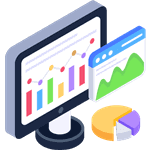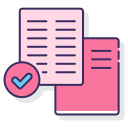 Data analysis and presentation are centered on having access to a robust and versatile software solution is the cornerstone of success. Amidst the many options, Stata emerges as a frontrunner, offering unparalleled assistance in transforming complex data into compelling visual narratives. Our analysts, researchers, and students alike find solace in Stata's user-friendly interface and powerful features, making it the preferred choice for data presentation. The ability to present data in a clear and concise manner has become an invaluable skill. Stata not only simplifies this process but also elevates it to an art form, allowing users to create sophisticated graphs, charts, and tables that elucidate patterns, trends, and insights. The software's unique blend of structured Stata data analysis and presentation and dynamic visualization serves as a catalyst for effective communication, bridging the gap between raw data and comprehensible insights. The importance of data reproducibility cannot be overstated in the realm of research and analysis. Stata addresses this concern by providing a comprehensive record of all commands and transformations applied to the data. This transparency not only enhances the credibility of findings but also fosters a culture of collaboration and knowledge sharing. In a world where first impressions matter, Stata's attention to detail shines through its dynamic data labeling and publication-quality output features. These aspects lend an air of professionalism to presentations, ensuring that information is not only accurate but also visually engaging. The software's integration of statistical analysis capabilities empowers users to seamlessly transition from data exploration to insightful interpretation, streamlining the entire workflow. Stata's prowess extends beyond mere software; it encompasses a supportive and vibrant user community. Our experts ensure that users are never alone in their data presentation process. As seasoned Stata experts, we help individuals tap into a wealth of knowledge, enhancing their proficiency in utilizing the software to its fullest potential. Here are pivotal factors that position Stata as the leading tool for transforming data into impactful visual narratives. From its seamless data integration capabilities to its dynamic graphing features, Stata's strengths are manifold, and our exploration will enlighten the reasons behind its status as the go-to software for info presentation excellence.
Data analysis and presentation are centered on having access to a robust and versatile software solution is the cornerstone of success. Amidst the many options, Stata emerges as a frontrunner, offering unparalleled assistance in transforming complex data into compelling visual narratives. Our analysts, researchers, and students alike find solace in Stata's user-friendly interface and powerful features, making it the preferred choice for data presentation. The ability to present data in a clear and concise manner has become an invaluable skill. Stata not only simplifies this process but also elevates it to an art form, allowing users to create sophisticated graphs, charts, and tables that elucidate patterns, trends, and insights. The software's unique blend of structured Stata data analysis and presentation and dynamic visualization serves as a catalyst for effective communication, bridging the gap between raw data and comprehensible insights. The importance of data reproducibility cannot be overstated in the realm of research and analysis. Stata addresses this concern by providing a comprehensive record of all commands and transformations applied to the data. This transparency not only enhances the credibility of findings but also fosters a culture of collaboration and knowledge sharing. In a world where first impressions matter, Stata's attention to detail shines through its dynamic data labeling and publication-quality output features. These aspects lend an air of professionalism to presentations, ensuring that information is not only accurate but also visually engaging. The software's integration of statistical analysis capabilities empowers users to seamlessly transition from data exploration to insightful interpretation, streamlining the entire workflow. Stata's prowess extends beyond mere software; it encompasses a supportive and vibrant user community. Our experts ensure that users are never alone in their data presentation process. As seasoned Stata experts, we help individuals tap into a wealth of knowledge, enhancing their proficiency in utilizing the software to its fullest potential. Here are pivotal factors that position Stata as the leading tool for transforming data into impactful visual narratives. From its seamless data integration capabilities to its dynamic graphing features, Stata's strengths are manifold, and our exploration will enlighten the reasons behind its status as the go-to software for info presentation excellence.
What Makes Stata the most preferred software for presenting data?
- Seamless Data Integration: Stata's ability to seamlessly integrate various data formats is a game-changer since researchers often work with data from different sources, and Stata simplifies the process of merging and cleaning diverse datasets which streamlines data preparation, allowing users to focus on the analysis and presentation aspects.
- Advanced Graphing Capabilities: When it comes to visualizing data, Stata truly shines as it has a wide range of customizable graph types, and users can create visually appealing and insightful graphs with ease. From basic bar charts to complex scatter plots and heatmaps, Stata's graphing capabilities cater to both beginners and experienced researchers who need help with data presentation using Stata software.
- Effortless Reproducibility: Stata promotes transparency by providing a comprehensive record of commands and data transformations used in the analysis which ensures that others can replicate your work, enhancing the credibility and reliability of your findings.
- Dynamic Data Labels: Users can label data points, axes, and legends with meaningful names and units, enhancing the clarity of the presentation which contributes to a professional and polished final product.
- Publication-Quality Output: For researchers aiming to publish their findings, Stata offers publication-quality output. Whether it's exporting graphs to vector formats or generating tables in LaTeX, the software ensures that your presentation maintains its integrity and aesthetics across various platforms.
- Built-in Statistical Analysis: Stata is not just about presenting data; it's also a robust statistical analysis tool. The software provides a wide array of statistical tests, regression models, and data manipulation functions. This integration of analysis and presentation in one platform streamlines the workflow and minimizes the need to switch between different software.
- Automation and Batch Processing: Efficiency is key in presentations, especially when dealing with large datasets as Stata's automation and batch processing capabilities enable users to apply the same set of commands to multiple files, saving time and ensuring consistency in the presentation of data across different segments.
When it comes to project presentations, Stata emerges as an invaluable tool, embodying a symphony of features that orchestrate a harmonious blend of functionality and ease. With its prowess in seamlessly integrating diverse data sources, empowering graphing capabilities, and a steadfast commitment to reproducibility, Stata stands tall as a beacon of reliability. The dynamic data labeling and publication-quality output foster a culture of precision and professionalism, while the software's fusion of statistical analysis and presentation redefines efficiency. The chorus of automation and batch processing echoes the ethos of time optimization, setting the stage for a seamless and streamlined journey in presenting data using Stata. Bolstered by an active user community and robust support, Stata's performance rises to the level of success for researchers and students. In a data-driven world, where resonance matters, our experts use Stata to conduct the symphony of research study presentation with virtuosity, leaving an indelible impact on clarity, insight, and understanding.
Stata Data Presentation Help – We Deliver the Most Ideal Results
 In the ever-evolving field of data presentation, the ability to distill complex information into comprehensible insights is a skill that can wield tremendous influence. Stata is a dynamic statistical software that empowers researchers and analysts to transform raw data into compelling visual narratives. Custom Writing Bay recognizes the pivotal role of data presentations in conveying the essence of research findings. Let us get into the realm of Stata's prowess, uncovering how it simplifies customization, delving into the intricacies of time investment, and shedding light on pitfalls to circumvent. Data has authority and the manner in which information is presented holds the key to fostering understanding and driving decision-making. Stata, an exemplar in the field of statistical analysis software for data presentation, offers an array of features that facilitate the creation of tailored project presentations. These tools serve as a conduit for crafting captivating visualizations that transcend mere numbers, effectively communicating the story concealed within the data points. As specialists in guiding scholars and researchers, we are poised to elucidate the ways in which Stata's toolkit simplifies the often intricate process of presentation customization. Time is an invaluable resource and the endeavor of assembling data, conducting analyses, and fashioning presentations demands an investment of time that can be tiresome. We help explore the temporal aspect; discerning how swiftly our seasoned expert can harness Stata's potential to curate a presentation of substance. The timeline from data wrangling to the discovery of insights leads to the efficiency that Stata bestows upon the presentation creation journey. Exploring the ideology of data presentations using the Stata tool is not devoid of challenges. In our pursuit of delivering insightful guidance, we explain common pitfalls that can mar the impact of a presentation. From the perils of cluttered visuals to the art of data storytelling, we propose insights on how to sidestep these obstacles and ensure the fruition of a coherent and engaging data narrative. The judicious investment of time, and the avoidance of missteps, lies the key to unlocking data's transformative potential. Our commitment to fostering impactful presentations is steadfast, and our partnership with Stata elevates this commitment to new levels of excellence.
In the ever-evolving field of data presentation, the ability to distill complex information into comprehensible insights is a skill that can wield tremendous influence. Stata is a dynamic statistical software that empowers researchers and analysts to transform raw data into compelling visual narratives. Custom Writing Bay recognizes the pivotal role of data presentations in conveying the essence of research findings. Let us get into the realm of Stata's prowess, uncovering how it simplifies customization, delving into the intricacies of time investment, and shedding light on pitfalls to circumvent. Data has authority and the manner in which information is presented holds the key to fostering understanding and driving decision-making. Stata, an exemplar in the field of statistical analysis software for data presentation, offers an array of features that facilitate the creation of tailored project presentations. These tools serve as a conduit for crafting captivating visualizations that transcend mere numbers, effectively communicating the story concealed within the data points. As specialists in guiding scholars and researchers, we are poised to elucidate the ways in which Stata's toolkit simplifies the often intricate process of presentation customization. Time is an invaluable resource and the endeavor of assembling data, conducting analyses, and fashioning presentations demands an investment of time that can be tiresome. We help explore the temporal aspect; discerning how swiftly our seasoned expert can harness Stata's potential to curate a presentation of substance. The timeline from data wrangling to the discovery of insights leads to the efficiency that Stata bestows upon the presentation creation journey. Exploring the ideology of data presentations using the Stata tool is not devoid of challenges. In our pursuit of delivering insightful guidance, we explain common pitfalls that can mar the impact of a presentation. From the perils of cluttered visuals to the art of data storytelling, we propose insights on how to sidestep these obstacles and ensure the fruition of a coherent and engaging data narrative. The judicious investment of time, and the avoidance of missteps, lies the key to unlocking data's transformative potential. Our commitment to fostering impactful presentations is steadfast, and our partnership with Stata elevates this commitment to new levels of excellence.
How does Stata make it easy to customize data presentations?
- Graph Customization: Stata offers an extensive array of graph types, such as line charts, histograms, and heatmaps as its intuitive interface enables users to adjust colors, markers, and line styles. This empowers you to tailor each graph precisely to your data's characteristics, ensuring that the visual representation effectively communicates your insights.
- Flexible Labels and Annotations: With Stata, you can effortlessly add titles, axis labels, and data point annotations to your graphs which enhances the viewer's understanding by providing context and highlighting key data points, turning complex data into meaningful information.
- Color Palette Control: Stata's built-in color schemes simplify the process of selecting harmonious color combinations ensuring that your visuals maintain visual consistency, making it easier for your audience to differentiate between data elements without being overwhelmed by excessive colors.
- Data Subset Emphasis: Its ability to highlight specific subsets of your data through shading, patterns, or color variations is invaluable allows you to draw attention to specific trends, variations, or outliers, guiding your audience's focus to the most relevant aspects of your analysis.
- Easy Data Transformations: The software simplifies the process of data manipulation through its diverse range of functions. Whether you need to aggregate, reshape, or compute new variables, Stata's functionalities provide a seamless way to refine your data before creating visualizations, ensuring that your presentations reflect the insights you want to convey.
- Automation and Reproducibility: Users can script their study presentation processes, enabling automation and reproducibility. With the best Stata data presentation help, you can ensure that your presentations remain consistent and up-to-date even as your data evolves, saving valuable time by eliminating the need for manual adjustments when new data is added.
- Multiple Export Formats: Stata's compatibility with various export formats facilitates the integration of your data representations into different contexts. Whether you need to include them in reports, articles, or slide presentations, Stata's export options empower you to seamlessly incorporate your visualizations into your preferred medium, enhancing the accessibility of your insights.
How long does it take a Stata expert to create a data presentation?
Creating a presentation is a meticulous process that involves multiple stages, from data preparation to visualization and formatting. The time it takes for an expert to craft a compelling presentation for data can vary based on factors such as the complexity of the data, the depth of analysis required, and the level of customization desired. Our experienced data analysts or statisticians may spend approximately 5 to 10 hours to complete a comprehensive presentation. The initial phase involves importing raw data and performing data cleaning to ensure accuracy. Subsequent steps include running statistical analysis to extract meaningful insights and trends. The heart of the presentation lies in the visualization stage, where Stata's capabilities shine. Our analysts choose appropriate graph types that best convey the data's narrative, whether it's scatter plots, bar charts, or regression plots. Customization comes into play, as they tweak color palettes, labels, and annotations to enhance clarity and aesthetics. Once the visualizations are ready, our experts invest time in arranging them coherently, ensuring a logical flow of information. They focus on creating a storyline that guides the audience through the data's journey, ensuring that the presentation delivers insights effectively. Stata expedites the process by providing automation features and scripting options. This allows us to reproduce the presentation easily and make swift updates as new insights emerge. Furthermore, Stata's export formats enable seamless integration into reports, articles, or presentations. Factors influencing the timeline also include the presenter's familiarity with Stata's functionalities. Our proficiency in navigating the software expedites graph creation and data manipulation. While Stata significantly streamlines the creation of presentations for data gathered, the time invested depends on the complexities of the data and the presenter's skill set. The goal is to strike a balance between efficiency and quality, ensuring that the final presentation effectively communicates insights to the intended audience.
What are the mistakes to avoid when creating a data presentation with Stata?
- Cluttered Visuals: It's tempting to include every piece of data in your presentation, but overcrowded graphs with excessive data points, labels, and lines can overwhelm and confuse the audience. Simplify your visuals by focusing on the most important data and eliminating unnecessary elements.
- Inadequate Labeling: Neglecting to provide clear and informative labels for axes, titles, and data points can leave your audience puzzled as they are essential for understanding the context and meaning of the presented information.
- Inconsistent Formatting: Visual consistency is key to a professional and polished data presentation hence the need to avoid using too many colors, fonts, or graph formats that can distract from the main message and choose a cohesive and restrained approach to formatting.
- Ignoring Audience Understanding: Tailoring your presentation to your audience's familiarity with statistical concepts is crucial. Avoid using complex jargon without explanation, and provide context and definitions when introducing technical terms.
- Misleading Representation: Selecting inappropriate graph types or manipulating scales can distort the data's true representation. You should stay true to the data and choose graph types that accurately reflect the relationships you want to convey.
- Lack of Storytelling: A collection of graphs without a clear narrative can leave your audience disengaged which is why you need to craft a compelling story that guides your audience through the insights, highlighting the key findings and their implications.
Stata software is a great tool for simplifying the complex task of transforming raw data into meaningful insights. With its diverse range of customization options, from graph styles to labeling and annotations, Stata empowers users to craft presentations tailored to their data's narrative. The software's efficiency is exemplified by its capacity for automation and reproducibility, ensuring both accuracy and time-saving benefits. Stata's prowess aligns seamlessly with the expertise of our skilled analysts, resulting in presentations that bridge the gap between complexity and understanding. While Stata expedites the process, the creation of a captivating presentation extends beyond software capabilities. Understanding your audience, maintaining visual coherence, and weaving a compelling storyline are indispensable components. As pioneers in delivering effective project presentations, we emphasize the amalgamation of Stata's prowess with astute presentation strategies, guaranteeing that your insights not only inform but also inspire your audience.




